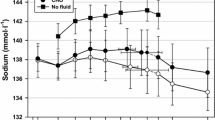Summary
Young Osborne-Mendel rats were given different diets ad libitum for 6 weeks. Food was either a purified powder with sucrose (15%) or commercial pellets, and drink was either distilled water or a sugar-containing (6%) sport-drink with or without added fluoride (F), magnesium (Mg) or both. Despite differences in the energy density of the diets, daily intakes were the same in terms of metabolisable energy and resulted in equal weight gains for all groups. Interscapular brown fat hypertrophied in response to powdered food, while both sugar-containing food and sport-drink were effective in accumulating white fat. When exposed to cold air at −20° C for 2–4 h, most of the rats were able to maintain normothermia. Only the rats fed pelleted food and given distilled water were less resistant to cold than the others. After exposure to cold, the reserves of muscle glycogen were least in those rats having the poorest performance in the cold. In contrast, the stores of liver glycogen, plasma glucose and adrenal ascorbic acid were associated with pelleted food, rather than with the exposure to cold or type of drink. It is concluded that the presence of purified, simple sugars, either in food or drink, is the most likely explanation of the results obtained. The F and Mg supplements to the sport-drink did not modify the parameters measured.
Similar content being viewed by others
References
Brotherhood JR (1984) Nutrition and sports performance. Sports Med 1:350–389
Costill DL (1988) Carbohydrates for exercise: dietary demands for optimal performance. Int J Sports Med 9:1–18
Costill DL, Gollnick PD, Jansson ED, Saltin B, Stein EM (1973) Glycogen depletion pattern in human muscle fibers during distance running. Acta Physiol Scand 89:374–383
Ekblom B (1987) Athletics and drinks (in Swedish). Näringsforskning 31:136–139
Freudenthal N (1980) Investigations on school children revealed connection between sports and dental caries (in Swedish). Tandläkartidningen 72:1329–1330
Häkkinen B (1981) Sport drinks — an erosive risk factor (in Finnish). Suom Hammaslääk Lehti 28:751–755
Harri M, Brockway JM (1985) Effect of dietary protein concentration and ambient temperature on the energy, protein and water metabolism of the rat. Br J Nutr 53:363–372
Harri M, Kuusela P (1986) Is swimming exercise or cold exposure for rats? Acta Physiol Scand 126:189–197
Harri M, Dannenberg T, Oksanen-Rossi R, Hohtola E, Sundin U (1984) Related and unrelated changes in response to exercise and cold in rats: a re-evaluation. J Appl Physiol 57:1489–1497
Hoijer DJ (1960) Metabolic function of ascorbic acid in acclimation to cold. Fed Proc 19:90–93
Hultman E (1967) Muscle glycogen in man determined in needle biopsy specimens. Method and normal values. Scand J Clin Lab Invest 19:209–217
Keen CL, Lowney P, Gershwin ME, Hurley LS, Stern JS (1987) Dietary magnesium intake influences exercise capacity and hematologic parameters in rats. Metabolism 36:788–793
Lamb DR, Brodowicz GR (1986) Optimal use of fluids of varying formulations to minimise exercise-induced disturbances in homeostasis. Sports Med 3:247–274
LeBlanc J, Labrie A (1981) Glycogen and nonspecific adaptation to cold. J Appl Physiol 51:1428–1432
LeBlanc J, Dussault J, Lupien D, Richard D (1982) Effect of diet and exercise on norepinephrine-induced thermogenesis in male and female rats. J Appl Physiol 52:556–561
Luoma H (1980) Fluoride and magnesium, two ions in the prevention of calcium salt imbalance, including caries prevention, in man and animals. Proc Finn Dent Soc 76:73–81
Luoma H, Nuuja T, Collan Y, Nummikoski P (1976) The effect of magnesium and fluoride on nephrocalcinosis and aortic calcification in rats given high sucrose diets with added phosphates. Calcif Tissue Res 20:291–302
Luoma H, Fejerskov O, Thylstrup A (1986) The effect of fluoride on dental plaque, tooth structure and dental caries. In: Thylstrup A, Fejerskov O (eds) Textbook of cariology. Munksgaard, Copenhagen, pp 299–334
Pratt K, Moody ML, Conlee RK, Rüddel H, Franz KB (1985) Changes in serum free fatty acids and magnesium during a marathon. Magnesium 4:207–208
Rothwell NJ, Stock MJ (1979) A role for brown adipose tissue in diet-induced thermogenesis. Nature 281:31–35
Rothwell NJ, Stock MJ, Warwick BP (1983) The effect of high fat and high carbohydrate cafeteria diets on diet-induced thermogenesis in the rat. Int J Obes 7:263–270
Saltin B, Karlsson J (1977) Die Ernährung des Sportlers. In: Hollmann W (ed) Zentrale Themen der Sportmedizin. Springer, Berlin Heidelberg New York, pp 132–146
Sorvari R, Kiviranta I, Luoma H (1988) Erosive effect of a sport drink mixture with and without addition of fluoride and magnesium on the molar teeth of rats. Scand J Dent Res 96:226–231
Sorvari R, Koskinen-Kainulainen M, Sorvari T, Luoma H (1986) Effect of a sport drink mixture with and without addition of fluoride and magnesium on plaque formation, dental caries and general health of rats. Scand J Dent Res 94:483–490
Sundin U, Nechad M (1983) Trophic response of rat brown fat by glucose feeding: involvement of sympathetic nervous system. Am J Physiol 244 (Cell Physiol 13):C 142-C 149
Zannoni V, Lynch M, Goldstein S, Sato P (1974) A rapid micromethod for the determination of ascorbic acid in plasma and tissues. Biochem Med 11:41–48
Author information
Authors and Affiliations
Rights and permissions
About this article
Cite this article
Sorvari, R., Harri, M. Effect of sport-drink with and without fluoride and magnesium supplements on rat performance. Europ. J. Appl. Physiol. 58, 738–743 (1989). https://doi.org/10.1007/BF00637385
Accepted:
Issue Date:
DOI: https://doi.org/10.1007/BF00637385




